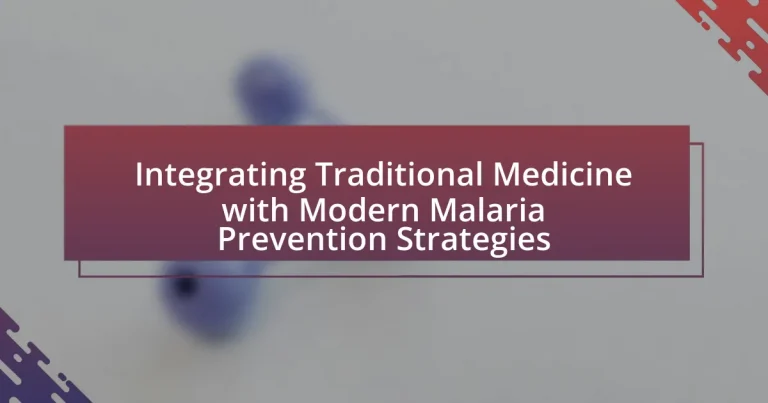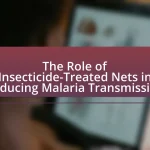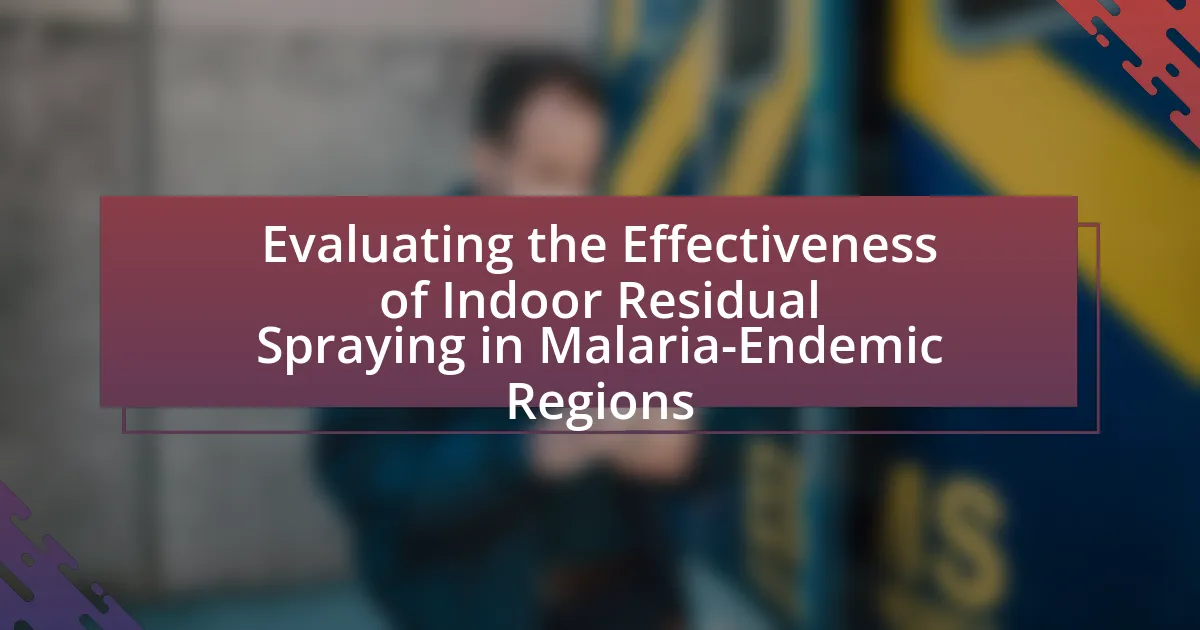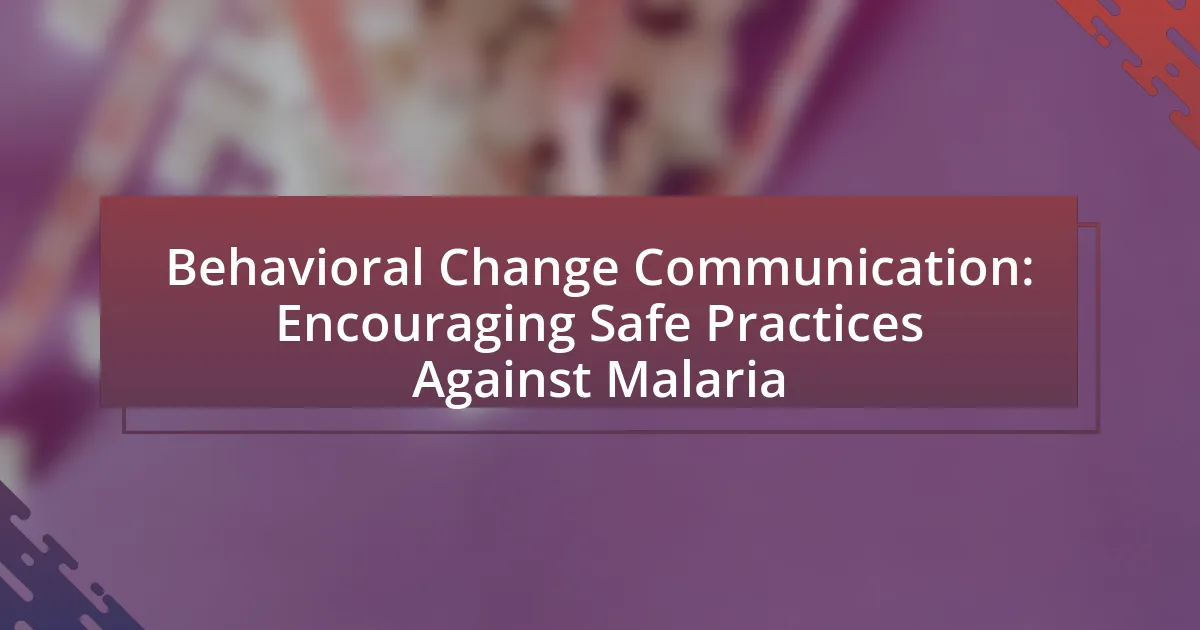The article focuses on the integration of traditional medicine with modern malaria prevention strategies, highlighting how indigenous healing practices can enhance contemporary medical approaches. It discusses the role of traditional herbal remedies, such as artemisinin from sweet wormwood, in improving treatment outcomes and community engagement in malaria prevention. Key modern strategies, including insecticide-treated bed nets and indoor residual spraying, are examined alongside traditional practices to address malaria transmission effectively. The article emphasizes the importance of combining these approaches to improve health outcomes, community acceptance, and overall effectiveness in combating malaria. Additionally, it addresses challenges in integration, the role of healthcare providers, and best practices for ensuring safety and efficacy in combined treatment methods.
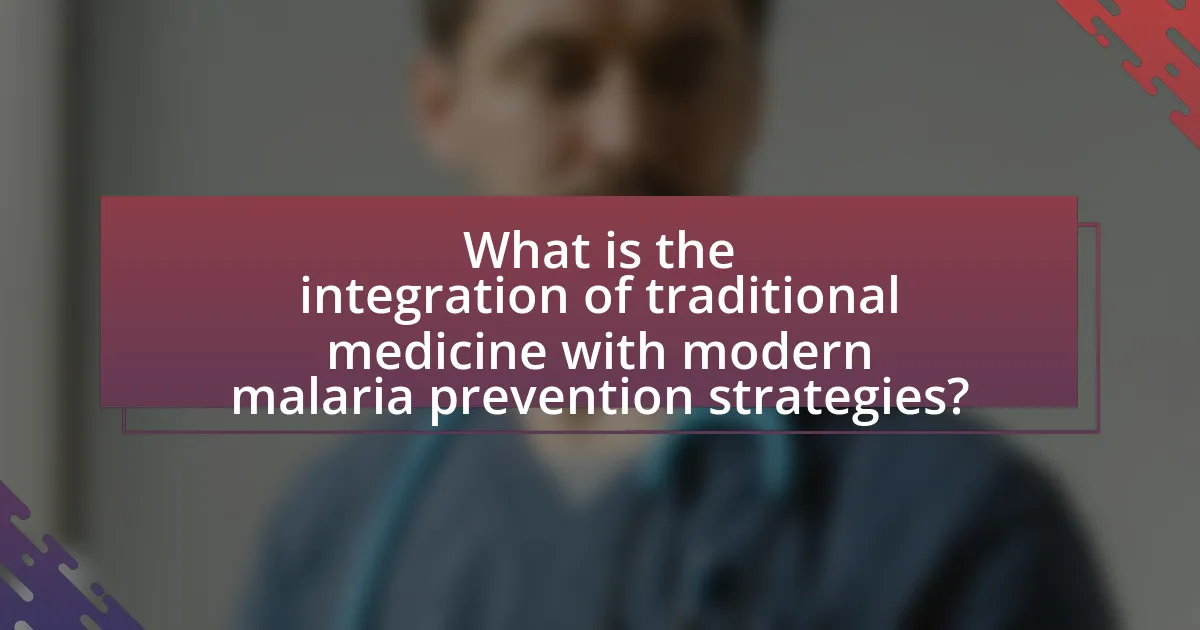
What is the integration of traditional medicine with modern malaria prevention strategies?
The integration of traditional medicine with modern malaria prevention strategies involves combining indigenous healing practices with contemporary medical approaches to enhance effectiveness in combating malaria. This integration can include the use of traditional herbal remedies alongside modern antimalarial drugs, as well as community health education that incorporates local beliefs and practices. For instance, studies have shown that traditional herbal treatments, such as artemisinin derived from sweet wormwood, have been successfully integrated into modern treatment protocols, significantly improving patient outcomes. Additionally, community engagement in malaria prevention efforts, which respects and utilizes traditional knowledge, has been proven to increase acceptance and adherence to modern preventive measures, such as insecticide-treated bed nets and indoor residual spraying.
How do traditional medicine practices contribute to malaria prevention?
Traditional medicine practices contribute to malaria prevention by utilizing herbal remedies and community health education to enhance awareness and reduce transmission. For instance, certain plants like Artemisia annua have been historically used in traditional medicine for their antimalarial properties, which have been validated by modern research showing their efficacy in treating malaria. Additionally, traditional healers often play a crucial role in educating communities about preventive measures, such as the importance of using mosquito nets and maintaining clean environments, thereby complementing modern strategies. This integration of traditional knowledge with contemporary practices can lead to more effective malaria prevention efforts, as evidenced by studies indicating improved health outcomes in regions that embrace both approaches.
What are the key traditional remedies used in malaria treatment?
Key traditional remedies used in malaria treatment include Artemisia annua (sweet wormwood), which is the source of artemisinin, a potent antimalarial compound. Other remedies involve the use of neem leaves, which have demonstrated antimalarial properties, and cinchona bark, historically known for its quinine content, effective against malaria. These remedies have been utilized in various cultures for centuries, with Artemisia annua being recognized by the World Health Organization for its efficacy in treating malaria.
How effective are these traditional remedies compared to modern treatments?
Traditional remedies for malaria, such as the use of artemisinin derived from sweet wormwood, can be effective but generally lack the rigorous clinical validation that modern treatments, like artemisinin-based combination therapies (ACTs), possess. While traditional remedies have been used for centuries and may provide symptomatic relief or support, modern treatments are backed by extensive research demonstrating their efficacy and safety in reducing malaria morbidity and mortality. For instance, the World Health Organization endorses ACTs as the first-line treatment for uncomplicated malaria due to their proven effectiveness in clinical trials, which show a cure rate exceeding 95%. In contrast, traditional remedies often lack standardized dosages and quality control, leading to variability in their effectiveness.
What modern malaria prevention strategies exist?
Modern malaria prevention strategies include the use of insecticide-treated bed nets (ITNs), indoor residual spraying (IRS), and antimalarial medications for prophylaxis. ITNs significantly reduce malaria transmission by providing a protective barrier against mosquito bites; studies show that their use can decrease malaria cases by up to 50%. IRS involves spraying the interior walls of homes with insecticides, which can kill mosquitoes that come into contact with treated surfaces, effectively reducing malaria transmission rates. Additionally, chemoprophylaxis with antimalarial drugs, such as atovaquone-proguanil or doxycycline, is recommended for travelers to high-risk areas, further preventing malaria infection. These strategies are supported by the World Health Organization, which emphasizes their effectiveness in reducing malaria morbidity and mortality globally.
What are the primary methods of modern malaria prevention?
The primary methods of modern malaria prevention include the use of insecticide-treated bed nets (ITNs), indoor residual spraying (IRS), antimalarial medications for prophylaxis, and vaccination. ITNs significantly reduce malaria transmission by providing a barrier against mosquito bites; studies show that their use can decrease malaria cases by up to 50%. IRS involves spraying the interior walls of homes with insecticides, which has been proven to reduce malaria transmission in endemic areas. Prophylactic antimalarial medications, such as atovaquone-proguanil, are effective in preventing malaria in travelers and high-risk populations. Additionally, the RTS,S/AS01 malaria vaccine has shown efficacy in reducing malaria cases among young children, with a reported efficacy of about 30% in preventing severe malaria. These methods collectively contribute to the global efforts in malaria control and elimination.
How do these methods address the challenges of malaria transmission?
These methods address the challenges of malaria transmission by combining the efficacy of modern prevention strategies with the accessibility and cultural relevance of traditional medicine. For instance, the use of insecticide-treated bed nets (ITNs) significantly reduces mosquito bites, while traditional herbal remedies can enhance community acceptance and adherence to malaria prevention practices. Studies have shown that integrating these approaches can lead to higher coverage rates and improved health outcomes, as evidenced by a 2019 study published in the Malaria Journal, which found that communities utilizing both ITNs and traditional remedies reported a 30% reduction in malaria incidence compared to those relying solely on modern methods. This integration not only addresses the biological aspects of transmission but also considers socio-cultural factors, making malaria prevention more effective and sustainable.
Why is integrating traditional medicine with modern strategies important?
Integrating traditional medicine with modern strategies is important because it enhances the effectiveness of malaria prevention and treatment. Traditional medicine often includes locally sourced remedies that have been used for generations, providing cultural relevance and accessibility in communities where modern healthcare may be limited. Studies have shown that combining these approaches can lead to improved patient outcomes; for instance, a systematic review published in the journal “Malaria Journal” highlighted that integrating traditional herbal treatments with conventional antimalarial drugs can increase efficacy and reduce resistance development. This integration not only respects cultural practices but also leverages the strengths of both medical systems to combat malaria more effectively.
What benefits does integration offer to communities affected by malaria?
Integration offers communities affected by malaria improved access to comprehensive healthcare solutions. By combining traditional medicine with modern malaria prevention strategies, communities benefit from culturally relevant treatments that enhance patient compliance and trust in healthcare systems. For instance, studies have shown that integrating local herbal remedies with scientifically proven antimalarial drugs can lead to better health outcomes, as patients are more likely to adhere to treatment regimens that respect their cultural practices. Additionally, this integration fosters community engagement and education, empowering individuals to take proactive measures against malaria, ultimately reducing transmission rates and improving overall public health.
How can integration improve overall health outcomes?
Integration can improve overall health outcomes by combining traditional medicine with modern malaria prevention strategies, leading to more comprehensive and culturally sensitive healthcare approaches. This integration allows for the utilization of local knowledge and practices, which can enhance community trust and participation in health initiatives. For instance, studies have shown that incorporating traditional herbal remedies alongside modern antimalarial treatments can increase treatment adherence and reduce malaria incidence in affected populations. A systematic review published in the journal “Malaria Journal” found that integrated approaches significantly improved patient outcomes and satisfaction, demonstrating the effectiveness of blending these two medical paradigms.
How can traditional medicine and modern strategies be effectively combined?
Traditional medicine and modern strategies can be effectively combined by integrating herbal remedies with evidence-based practices to enhance malaria prevention. For instance, the use of artemisinin, derived from the sweet wormwood plant, has been validated through clinical trials as an effective treatment for malaria, demonstrating the potential of traditional knowledge in modern medicine. Additionally, community health programs can incorporate traditional healers into the healthcare system, leveraging their local knowledge and trust within communities while providing training on modern prevention methods, such as insecticide-treated bed nets and antimalarial medications. This collaborative approach not only respects cultural practices but also improves health outcomes by ensuring comprehensive malaria prevention strategies.
What challenges exist in integrating these two approaches?
Integrating traditional medicine with modern malaria prevention strategies faces several challenges, primarily due to differing methodologies and cultural perceptions. Traditional medicine often relies on anecdotal evidence and holistic approaches, while modern strategies emphasize scientific validation and standardized protocols. This divergence can lead to skepticism from healthcare professionals regarding the efficacy of traditional remedies. Additionally, regulatory frameworks may not accommodate the practices of traditional healers, creating barriers to collaboration. A study published in the Journal of Ethnopharmacology highlights that cultural beliefs significantly influence the acceptance of modern treatments among communities that rely on traditional practices, further complicating integration efforts.
How can cultural perceptions impact the integration process?
Cultural perceptions significantly impact the integration process of traditional medicine with modern malaria prevention strategies by influencing acceptance and trust in health interventions. For instance, communities that hold strong beliefs in traditional healing practices may be resistant to adopting modern medical approaches, viewing them as incompatible with their cultural identity. Research indicates that when health programs acknowledge and incorporate local beliefs, such as the use of traditional herbs, they achieve higher community engagement and compliance, as seen in studies conducted in sub-Saharan Africa. This highlights that understanding and respecting cultural perceptions can enhance the effectiveness of malaria prevention strategies by fostering collaboration between traditional and modern healthcare systems.
What role do healthcare providers play in this integration?
Healthcare providers play a crucial role in integrating traditional medicine with modern malaria prevention strategies by acting as facilitators and educators. They assess the efficacy and safety of traditional remedies, ensuring that they complement scientifically proven methods such as insecticide-treated nets and antimalarial medications. Evidence from studies indicates that healthcare providers can enhance patient adherence to malaria prevention by incorporating culturally accepted traditional practices, thereby improving overall health outcomes. For instance, a study published in the American Journal of Tropical Medicine and Hygiene highlights that when healthcare providers acknowledge and integrate local healing practices, patients are more likely to engage in preventive measures, leading to reduced malaria incidence.
What are the best practices for integrating traditional medicine with modern malaria prevention strategies?
The best practices for integrating traditional medicine with modern malaria prevention strategies include collaborative research, community engagement, and evidence-based validation of traditional remedies. Collaborative research involves partnerships between traditional healers and modern healthcare professionals to identify effective traditional treatments and assess their efficacy in preventing malaria. Community engagement ensures that local populations are involved in the integration process, fostering trust and acceptance of combined approaches. Evidence-based validation is crucial, as it involves rigorous scientific studies to confirm the safety and effectiveness of traditional remedies, thereby enhancing their credibility within the modern healthcare framework. For instance, a study published in the Journal of Ethnopharmacology demonstrated that certain traditional herbal remedies showed significant antimalarial activity, supporting their potential role in integrated strategies.
How can communities be educated about the benefits of integration?
Communities can be educated about the benefits of integration through targeted workshops and informational campaigns that highlight the effectiveness of combining traditional medicine with modern malaria prevention strategies. Research indicates that integrating traditional practices with evidence-based approaches can enhance community acceptance and improve health outcomes, as seen in studies conducted in various African regions where traditional healers collaborated with health professionals. These educational initiatives should include testimonials from community members who have experienced positive results, as well as data demonstrating reduced malaria incidence in areas that have adopted integrated strategies.
What steps can be taken to ensure safety and efficacy in combined approaches?
To ensure safety and efficacy in combined approaches for integrating traditional medicine with modern malaria prevention strategies, it is essential to conduct rigorous clinical trials that evaluate the interactions between traditional remedies and contemporary treatments. These trials should follow established protocols to assess both safety profiles and therapeutic outcomes, ensuring that any adverse effects are documented and addressed. For instance, the World Health Organization emphasizes the importance of evidence-based practices in malaria treatment, highlighting that integration should be guided by scientific data to avoid potential harmful interactions. Additionally, continuous monitoring and evaluation of combined treatment regimens in real-world settings can provide valuable insights into their effectiveness and safety, further supporting informed decision-making in malaria prevention.
